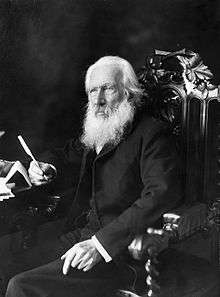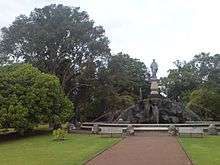John Logan Campbell (politician)
| Sir John Logan Campbell | |
|---|---|
 John Logan Campbell as an elderly man | |
| 17th Mayor of Auckland City | |
|
In office 8 May 1901 – 25 July 1901 | |
| Preceded by | David Goldie |
| Succeeded by | Alfred Kidd |
| Personal details | |
| Born |
3 November 1817 Edinburgh Scotland |
| Died | 22 June 1912 (aged 94) |
| Nationality |
|
| Relations |
John Cracroft Wilson (father-in-law) Michael Campbell (great-great-great-grandson) |
| Occupation | politician |
| Known for | Mayor of Auckland City |
Sir John Logan Campbell (3 November 1817 – 22 June 1912) was a prominent New Zealand public figure. He was the son of Doctor John Campbell and his wife Catherine and grandson of the 3rd baronet of Aberuchil and Kilbryde Castle, near Dunblane, Perthshire. He was described by his contemporaries as "the father of Auckland".
Early life
.jpg)
John Logan Campbell was born in Edinburgh, Scotland, on 3 November 1817 the third but only surviving son. He had four sisters but his two elder brothers had died by the time he reached the age of 2.[1] Campbell graduated in medicine from the University of Edinburgh in 1839[2] and later that year sailed for the antipodes, New South Wales, as a surgeon on the emigrant ship Palmyra.[3]
Migration to New Zealand
In 1840, he came to New Zealand, arriving first in Coromandel and then the then capital of New Zealand, Auckland, which had been founded by Governor William Hobson. Campbell and William Brown (a Scottish lawyer) who arrived at the same time, were the first Europeans to settle in the area.
Campbell and Brown built the first house in Auckland (Acacia Cottage,[4] which still survives), and opened the first shop. John Logan Campbell quickly became prominent in Auckland, both in business circles and in public life. He was a director of the Bank of New Zealand, the New Zealand Loan and Mercantile Agency Company, and the New Zealand Insurance Company.[3]
Auckland Province

Campbell was appointed to the Auckland Executive Council on 20 March 1855, and he served until 15 September of that year.[5] He was then Superintendent of Auckland Province from 25 November 1855 to 17 September 1856.[6]
Member of Parliament
| Parliament of New Zealand | ||||
| Years | Term | Electorate | Party | |
| 1855–1856 | 2nd | City of Auckland | Independent | |
| 1860 | 2nd | Suburbs of Auckland | Independent | |
Campbell entered the 2nd New Zealand Parliament, representing the electorates of the City of Auckland 1855–1856 (resigned). He was elected unopposed on 4 August 1860 in the Suburbs of Auckland electorate,[7] replacing Joseph Hargreaves.[8] Campbell retired at the end of the 2nd Parliament in later in 1860. He was a minister without portfolio in the government of Edward Stafford between June and November 1856.
Middle years
Campbell was a successful businessman and had entered into a partnership with William Brown in 1840 beginning operations as Auckland's first merchant firm, Brown and Campbell. By 1856 Campbell and Brown decided that their enterprises and properties, now worth £110,000, could be entrusted to a salaried manager, while they lived on the dividends as expatriates. Brown and his family left early in the year, but Campbell's departure was delayed. Much against his inclinations he became caught up in politics, serving as provincial superintendent, then as a member of the House of Representatives for the City of Auckland, and briefly (June to November 1856) as a member of the colony's first stable, responsible ministry under E. W. Stafford. These 'earthly baubles' he gladly resigned in September. On 20 November 1856 he left the colony, he hoped for good.
While travelling abroad he married, Emma Wilson on 25 February 1858. Apart from an interlude during 1860 and 1861, when he was obliged to go to Auckland to reinvigorate the firm – now called Brown Campbell and Company – and to install a resident partner, the Campbells lived in various parts of Europe until 1871.
On his return early in 1871 Campbell took over full control. Two years later he bought out Brown's partnership share for over £40,000. Becoming a part of the business community again he became involved with the Bank of New Zealand, the New Zealand Loan and Mercantile Agency Company, the New Zealand Insurance Company, and related companies. He founded Auckland's first school of art in 1878 and supported it for 11 years.
When depression overwhelmed Auckland in 1885 and the Stock Market collapsed in 1886 there began a desperate struggle for financial survival. Campbell sold several businesses and properties concentrating his energies on Brown Campbell and Company, a brewery and liquor importer. Campbell retained his properties at One Tree Hill partly because he wanted to create a suitable residence for his family. He envisaged an Italianate mansion similar to James Williamson's at Hillsborough, surrounded by an elegant estate. He set about planting trees to create a suitable landscape garden.
His wife, however, had other ideas and the house, Killbryde, was eventually built in Parnell, a location much more handy to town. This property is now part of the Parnell Rose Gardens and Dove Myer Robinson Park, the house was demolished in 1924. In his later years Campbell was concerned about the increasing suburban development of Auckland and decided to donate his remaining farmland at One Tree Hill to the city as a public amenity to be called Corinth Park - named after a part of Greece which Campbell had admired on his travels. His planting of groves of olive trees may have been connected to this.
The presentation of the park would probably have taken place after Campbell's death in the form of a bequest had not providence intervened in the form of the Royal Tour of 1901.
Cornwall Park
%2C_Dr_J_Logan_Campbell.jpg)
In 1901 Doctor John Logan Campbell was approached to be Mayor of Auckland for the royal visit that year (photo in mayoral robes), as David Goldie a temperance advocate did not want to toast the visiting Duke and Duchess of Cornwall and York with alcohol.
Rather than incur an election at short notice it was decided to honour Campbell with the position. Campbell only accepted on the grounds that it was completely honorary and that he wouldn't be involved in any actual politics. He was elected by the councillors, not the electorate. He resigned from the mayoralty the month after the royal visit. During the royal visit, Logan Campbell donated Cornwall Park to the people of New Zealand and named it after the Duke and Duchess.
Later life
John Logan Campbell received a knighthood in 1902. He lived long enough to witness the erection of the bronze statue of him in Mayoral Robes at the Manukau Road entrance to Cornwall Park. He died on 22 June 1912. He is buried on the summit of Auckland's famous One Tree Hill, which he had named, in the middle of Cornwall Park. He had always intended that the summit would be the location of a monument to the Maori people and left instructions and funds for its erection in his will and Trust Deeds. The Trustees felt that development of the park as a public facility took immediate priority and so construction of the obelisk did not commence until the late 1930s. This meant the official dedication was delayed as the Maori elders did not wish to formally dedicate it during a time of war. His grave is located in the middle of the flat platform which serves as the forecourt to the monument.
Notes
- ↑ R C J Stone, Poenamo Revisited, Godwit 2012 ISBN 978 1 86979 798 0
- ↑ List of the graduates in medicine in the University of Edinburgh from MDCCV to MDCCCLXVI, Edinburgh 1867
- 1 2 Stone, R. C. J. "Campbell, John Logan - Biography". Dictionary of New Zealand Biography. Ministry for Culture and Heritage. Retrieved 31 March 2012.
- ↑ http://www.waymarking.com/waymarks/WM7735_Acacia_Cottage_Cornwall_Park_Auckland_New_Zealand
- ↑ Scholefield 1950, p. 181.
- ↑ Scholefield 1950, p. 179.
- ↑ "Election for the Suburbs". Daily Southern Cross. XVII (1319). 7 August 1860. p. 2. Retrieved 23 June 2010.
- ↑ Cyclopedia Company Limited (1902). "Mr. Joseph Hargreaves". The Cyclopedia of New Zealand : Auckland Provincial District. Christchurch. Retrieved 23 June 2010.
References
- Scholefield, Guy (1950) [First ed. published 1913]. New Zealand Parliamentary Record, 1840–1949 (3rd ed.). Wellington: Govt. Printer.
- Stone, R.C.J. (2007) - Logan Campbell's Auckland: tales from the early years. Auckland University Press. Auckland. ISBN 978-1-86940-393-5
External links
| Wikimedia Commons has media related to John Logan Campbell. |
- Cornwall Park Trust Board's biography of Logan Campbell
- Background to Cambell's short Auckland mayoralty
- Photo of residence Kilbryde
- Mennell, Philip (1892). "
 Campbell, John Logan". The Dictionary of Australasian Biography. London: Hutchinson & Co. Wikisource
Campbell, John Logan". The Dictionary of Australasian Biography. London: Hutchinson & Co. Wikisource
| Political offices | ||
|---|---|---|
| Preceded by William Brown |
Superintendent of Auckland Province 1855–1856 |
Succeeded by John Williamson |
| Preceded by David Goldie |
Mayor of Auckland City 1901 |
Succeeded by Alfred Kidd |
| New Zealand Parliament | ||
| Preceded by Joseph Hargreaves |
Member of Parliament for Suburbs of Auckland 1860 Served alongside: Theophilus Heale |
Constituency abolished |